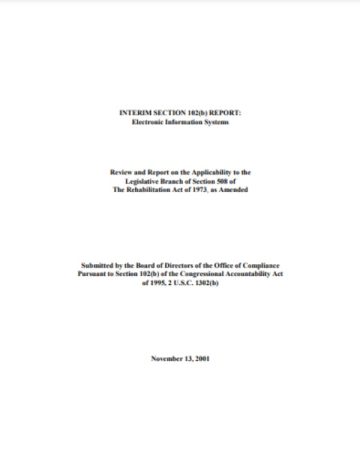I. Introduction
The Board of Directors (“the Board”) is charged with monitoring Federal law relating to terms and conditions of employment and access to public services and accommodations. The Congressional Accountability Act instructs the Board to report to Congress biannually: (1) whether or not those provisions are applicable to the Legislative Branch; and (2) whether inapplicable provisions should be made applicable to the Legislative Branch. Section 102(b)(1)&(2) of the Congressional Accountability Act (CAA), (2 U.S.C. 1302(b)(1)&(2)).
However, the CAA does not prohibit the Board from reporting to Congress on an interim basis, in appropriate circumstances, when such a report would best effectuate the purposes of the statute.
II. Section 508, Rehabilitation Act Amendments of 1998
The Board’s December 31, 2000 Report did not address certain 1998 amendments1 to section 508 of the Rehabilitation Act of 1973 (29 U.S.C. 794d), which subsequently were implemented by Executive Branch regulation in June 2001.2 The essence of these amendments requires that Executive Branch agencies provide their disabled employees and disabled members of the public with access to an agency’s electronic data and information. For example, visually impaired persons must be able to utilize agency web sites through software that converts visual information to an effective audio format. In those rare instances where such compliance would impose an undue burden on an agency or department, section 508 permits delivery of those services in alternate manner. Section 508 does not apply to the employing offices covered by the CAA, or to the Congressional instrumentalities GAO, GPO, or Library of Congress.3
The section 508 amendments originated in Senate Bill S. 1579. The Labor and Human Resources Committee’s Report articulated that this legislation stemmed primarily from the need to “reestablish[] and realign[] the national workforce development and training system to make it more user-friendly and accessible.” Sen. Rept. 105-166 at 2 (Mar. 2, 1998). Thus, the legislation was primarily perceived as a vocational rehabilitation and training matter. However, there is no doubt that the particular purpose of the proposed amendments to section 508 was to:
